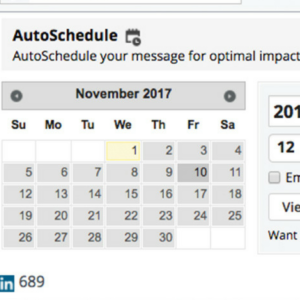11 Social Media Tips for the Small Business Owner
By LaRae Richards, Social Media Specialist for American Furniture Warehouse
If leveraged correctly, social media can be a powerful tool for small businesses. Sites like Facebook, Instagram, Twitter, Pinterest and LinkedIn all have the power to increase brand awareness, generate more sales, improve customer service and even increase a site’s search engine ranking, all at little to no cost. However, without a dedicated team devoted to a brand’s online presence, coming up with a social media strategy can be a daunting task for any entrepreneur. In this article, you’ll learn 11 ways to get your startup’s social media presence up and running.

1. Make a Plan
Before you begin populating social media accounts, take some time to think about your objectives, target audience and buyer personas. Are you hoping to grow brand awareness, improve customer retention or increase sales? Who is the target demographic that you’re trying to reach? How would you like your brand to be perceived by the public? Answering these basic questions will help you begin to construct your social media strategy.
2. Pick Your Platforms
Based on the answers to your questions above, you should identify what social media platforms best align with your goals and who you’re trying to reach. For example, if you’re a realtor, your objective may be to increase lead generations to your business, your target market might be married, 25-34-year-old first time home buyers and you’d like to be perceived as a trustworthy, knowledgeable, “no-nonsense” kind of real estate agent. Therefore, Facebook, LinkedIn, and YouTube would all be appropriate platforms, whereas Snapchat and Tumblr might not be. Still not sure? Check out this article from Forbes Magazine on Which Social Media Platforms Are Right for Your Business.
 3. Be All About Business
3. Be All About Business
When setting up your accounts, make sure you’re setting up a business account rather than a personal account whenever possible. This is important because business pages for Pinterest, Twitter and Facebook give you access to tools like creating ads, collecting data and even scheduling posts that personal accounts don’t have access to.
4. Play the Name Game
Try your best to keep your usernames the same across all your social media platforms. Keep in mind that your company’s name might not be available, or a username you’d like to use might be available on Facebook, but not Twitter. It’s a good idea to think of a few handles that are close to your namesake, short and easy to spell. Afterward, check all the social media sites you plan to use and see if the username is available.
 5. Optimize for Mobile
5. Optimize for Mobile
We often talk about the importance of optimizing your website for mobile devices, but what about optimizing social media for mobile devices? According to a recent study by comScore, nearly 80 percent of all social media users are viewing content on their mobile devices. With that in mind, it’s important to design your page’s cover photos, layouts, and posts to not only look great on desktop, but also mobile. Check out this Social Media Cheat Sheet for an up-to-date guide of social media image sizes.
6. Entertain Your Audience
While always keeping your objective, audience, and persona top-of-mind, share content that will resonate with your audience and is appropriate for each platform. For example, if you’re a clothing company, you could share pictures of your products on Instagram and compose infographics of how you would style a shirt with various accessories. If you’re a B2B electronic parts company, you might forego Instagram and Pinterest and instead share the latest industry news on LinkedIn and utilize YouTube to post product demonstration videos. For more ideas on what to post on each social media platform, click here.
 7. It’s All About Timing
7. It’s All About Timing
Social media is just as much an art as it is a science. Although there are lots of helpful infographic posts about when you should post online, a one-size-fits-all solution does not exist. It’s up to you to put in the time to research when your audience is using each social media platform. When you’re able to get your timing right, you’ll be able to reach a wider audience and engage with more users. To help you get started, read what these 20 Studies Say About the Best Time to Post on Social Media.
8. Be Ready to Work Every Day
Although a large majority of social media is free to use, you’ll have to be ready to commit time and energy to developing and nurturing your social presence. Your followers expect a response from you when they mention your brand and a rapid answer when they send you a direct message. They also will be on the lookout for fresh, new content at least weekly. To meet the demands of your followers, be ready to set at least 15-30 minutes aside twice a day to work on social media. If you find your time in short supply or you find yourself putting social media on the back burner, it may be time to think about paying someone to manage these platforms for you. For more information, head over to UpWork for information on How to Hire a Social Media Manager.
 9. Use Management Tools
9. Use Management Tools
To optimize your time, you might want to utilize one or several online social media management tools. There are quite a few to choose from that can do everything from scheduling posts to automatically posting your Instagram photos to Twitter. Check out this list of 15 Social Media Management Tools That Can Help Your Business Thrive to see what tools will best fit your needs.
10. Research Paid Advertising Solutions
Consider exploring paid advertising options to boost your social media performance. While most platforms have the ability to promote your content, Facebook is the indisputable winner of social advertising. The platform boasts over 2 million users across the world, robust advertising solutions, and advanced targeting. For a more in-depth overview of how Facebook and other social paid ads work, take a peek at this article by BigCommerce.com.
 11. Measure and Analyze
11. Measure and Analyze
To decipher what social media tactics are working and which ones aren’t, it is key to measure and analyze your results. Don’t rely on the number of followers you have to measure your success. Pay attention to the number of engagements (likes, posts, and shares) each of your posts are receiving, your website traffic and the impact social media has had on the objectives that you established early on in your social media plan. While most social media platforms have built-in tools to help you track your performance, you’ll want to use your own internal data. Google Analytics or even a third-party social media management tool to help you get a more accurate picture of your performance.
As you set off on your social media journey, remember that your business is growing and social media is constantly evolving. The platforms you prioritize today may be different tomorrow, your target market may be modified and your goals will probably shift over time. Prepare to remain flexible and do your best to educate yourself on the latest social media trends. With time and commitment, you’ll see your social media presence thrive!




